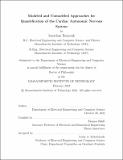| dc.description.abstract | The autonomic nervous system (ANS) is a branch of the nervous system that regulates involuntary functions within the body, such as blood pressure control (the baroreceptor reflex) and arousal. Tracking ANS activity in patients may provide information about traumatic brain injury, heart failure, stroke, diabetes, and sports performance; information that can ultimately aid in clinical decision making. In this work, we develop a non-invasive model-based approach and characterize a large class of unmodeled approaches for quantifying the autonomic nervous system, with the goal of improving interpretability.
Autonomic activity may be tracked in real-time through appropriate modeling of the baroreceptor reflex. We propose a causal, parametric beat-to-beat model, relating systolic blood pressure (input) to heart rate (output). This model is validated on data from 13 nonsmoking adult males, without any history of cardiopulmonary disease, subject to both pharmacological blockade and postural changes. The model tracks the expected effects of changing posture (P< 0.01) and sympathetic blockade (P< 0.05) on autonomic balance. In many cases, model parameters also exhibit greater sensitivity to changes in autonomic activity and balance than autonomic indices derived from the power spectral density of heart rate variability.
Heart rate variability (HRV) is a measure of the beat-to-beat variation of instantaneous heart rate that is commonly used as a measure of autonomic nervous system function. Using data collected from animal experiments, we show that it is related to heart rate (HR) and not an independent measure. In White New Zealand Rabbits (N=8), HR was titrated using a combination of electrical stimulation of the right cervical vagus nerve (simulating increased parasympathetic activity, decreasing heart rate) and the administration of intravenous propranolol (decreasing sympathetic activity through beta-adrenergic blockade, decreasing heart rate). Analyses of HRV against HR over the entire animal population as well as for each individual animal reveal a decaying exponential relationship between HRV and HR in mammals with an intact ANS.
Interpretation of HRV metrics is limited due to a lack of subject-level quantification of the variance implicit in both the random process that generates HRV as well as the methods by which HRV metrics are computed. We formulate a method for quantifying the variability of HRV metrics computed in the frequency domain, and then apply this method on the aforementioned human dataset. In the best case, the coefficients of variance for total power, low frequency power, and high frequency power metrics were found to be 28%, 32%, and 39%, respectively, for subjects before autonomic blockade. This level of variance translates to requiring over 170 minutes worth of data, collected under identical physiological conditions, in order to bound the estimated total power within 10% of the true value with probability 90%. Our results suggest that HRV metrics are highly variable and need to be reported with corresponding measurements of uncertainty. In addition, population estimates and inferences that are derived from HRV metrics need to adjust for subject-level variability. | |
